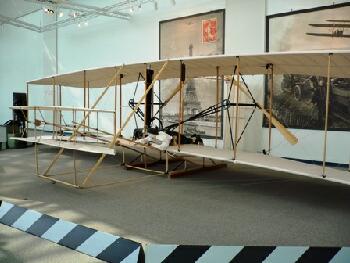| �@���ꂪMuseum of Flight�`�ٓ��W���`��!! �@�o�W�F�b�g�g���x���̎��H�L�^���ʐ^�Ɠ��L�ŏЉ�܂� |
BudgetTraveler's WORLD
�R�X�g�p�t�H�[�}���X�d���̌l���s
|
 ��
�� ��
�� ��
��
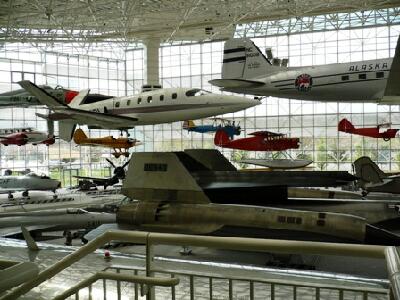
 ��
�� ��
�� ��
��
| |
|
||||||||||||||
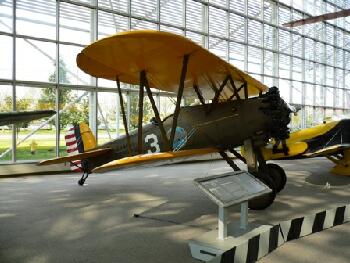 |
|
| |
|
||||||||||||||||||||||||
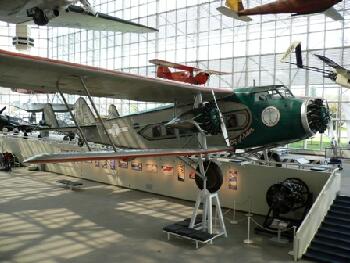
       |
Pioneer Pullman of the Air
Until the mid-1920s, American commercial airplanes were built for mail, not people. Boeing's Model 80, along with the Ford and Fokker tri-motors, were a new breed of passenger aircraft. The 80 first flew on July 27, 1928 and was flying Boeing Air Transport's(B.A.T) route two weeks later. The twelve-passenger Model 80 and the more-powerful 18-passenger 80A (re-designated 80A-1s when the tail surfaces were modified in 1930) stayed in service until 1934, when replaced by the all metal Boeing Model 247.
The museum's Model 80A-1 was retired from service with B.A.T in 1934. In 1941, it became a cargo aircraft with a construction firm in Alaska. To carry large equipment, including a massive 11,000-pound (4,950 kg) boiler, a cargo door was cut into the plane's side. After World War �U, the 80 was parked at an airfield and then discarded. It was recovered from a dump in 1960 and eventually brought to Seattle for restoration. It is the only surviving example of the Boeing Model 80 series.
The Luxury
A passenger flying in Boeing's earlier Model 40 was in for a very uncomfortable trip! People were packed like sardines into the cold and noisy fuselage. The advent of the Model 80 brought some comfort to travel. The 80A had a heated cabin, leather seats, individual reading lights and lavatory with hot and cold running water. Although the 80 had a luxurious interior, flying was tough by today's standards. The plane bumped along at low altitudes while engine noise made conversation almost impossible. And despite heaters, the cabin was very cold in the winter and scorching hot in summer months.
Ellen Church (1904-1965)
In 1930, Miss Ellen Church, a nurse and student pilot, convinced Boeing management to hire female cabin attendants for their Model 80 flights. It had previously been the co-pilot's duty to pass out box lunches, serve coffee, and tend to the passengers. Church reasoned that the sight of women working aboard the Boeing 80s would alleviate passenger fears. She and seven other nurses became America's first stewardesses. Serving on a trial basis, they were very popular and became a permanent part of American commercial aviation.
�������
1920�N��̔��܂ŁA�A�����J�̖��ԍq��@�͗��q�ł͂��A�X�ւ̗A������ȖړI�ł����B �{�[�C���O�E���f��80�́A1928�N7��27���ɏ���s���A�t�H�[�h�A�t�H�b�J�[�E�g���C���[�^�[�Ƌ��ɐV����̗��q�@�Ƃ��ēo�ꂵ�܂����B
����܂ł̃{�[�C���O���@��ł���Model40�̋�̗��́A�������ɂ����K���͂����܂���ł����B��q�͊����Ăđ��������@�̂ւ܂�ŃC���V�̂悤���ςݍ��܂�Ă����̂ł��B Model80�̓����́A���s�ɉ��K���������炵�܂����B80A�ɂ́A���x���߂��ꂽ�L���r���A�璣��̃V�[�g�A�ʂ̓Ǐ����A�����E�␅�̏o����ʏ����p�ӂ���Ă��܂����B80 �̓����͈ȑO�ɔ�ׂĂ����Ɖ��K�ɂȂ�܂������A��s�͍����̂���Ɣ�ׂ�Ƃ܂��܂����������̂������B��s�@�͋C���̉e�����Ȃ���ፂ�x���s���A��b�̓G���W�����o�������łقƂ�Ǖs�\�ɂȂ�̂ł����B�����āA�ݒu���ꂽ�͂܂��\���ł͂Ȃ��A�~�͊����A�Ẳ������Ԃ��͂ƂĂ������L���r���ɂȂ��Ă������̂ł��B
����ł��A�����Ƃ��Ă͉���I�ł��������f��80�́A�����12�l��胂�f���ƁA18�l���̉��nj^80A(�����ʂ�1930�N�ɕύX���ꂽ�Ƃ��A80A-1�ɕ��X)�́A�����{�f�B�̃{�[�C���OModel247���o�ꂷ��1934�N�܂ŁA���������邱�ƂɂȂ�܂����B
�W���@��Model 80A-1�́A1934�N�Ƀ{�[�C���O�q��A�����[�g�̃T�[�r�X����ސE���Ă���A���X�J�̌��Ǝ҂ɂ���ĉݕ��q��@�ƂȂ�܂����B�����ŁA��K�͂�1��1000�|���h(4,950kg)�̃{�C���[�Ȃǂ̑傫���ݔ����^�Ԃ��߂ɁA�@�̂̉����ɑ傫�ȃh�A������܂����B����E����ɂ́A���`�ɒ��Ԃ���A���u����Ă��܂������A�����1960�N�ɏC���̂��߂ɃV�A�g���ɌĂі߂����̂ł��B ���̋@�̓{�[�C���OModel80�V���[�Y�̗B��̎c���@�ƂȂ��Ă��܂��B
|
| |
|
||||||||||||||||||||||||
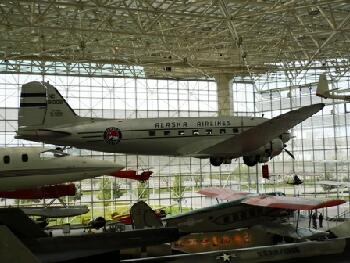
       |
Faithful Gooney Bird
The first versions of DC-3, called Douglas Sleeper Transports, began service with American Airlines in 1936. Demand for the unique airliner was high --- by 1938, DC-3s were flying an amazing 95 percent of the United States' and 90 percent of the world's airline traffic. During World War 2, the DC-3 design became a troop and cargo carrier called the C-47. Douglas built over 10,600 of the rugged and reliable planes and many are still flying today.
The museum's DC-3 was built in 1940 for American Airlines. It has seen service with various companies and flown over 60,000 hours. Today, it wears the livery of Alaska Airlines, which operated many DC-3s and C-47s after World War 2.
Time Flies
Compare the DC-3 with the three-engined Boeing Model 80A-1 parked below it in the Great Gallery. Seen together, they show a rapid progression of aircraft design. The Model 80's first flight was in 1928. The DC-3 followed just seven years later. The fabric and wood-covered biplane 80A looks like an antique compared to the all-metal monoplane hanging above. The bottom line for airlines? In just seven years, the new DC-3-series was much faster, had over twice the range, and could carry almost twice as many passengers as the first Boeing Model 80s.
Donald Wills Douglas (1892-1981)
Engineer Donald Douglas created his own company in 1920. His Cloudster was the first aircraft to lift a payload equal to its own weight and the Douglas World Cruisers were the first to fly around the world. The Douglas name became associated with commercial transport through the "Douglas Commercial" or "DC"-series. Douglas also built military transports, bombers, and attack airplanes. Donald Douglas was inducted into the National Aviation Hall of Fame in 1969 for his design of military and commercial aircraft.
�������
�_�O���XSleeper Transports�ƌĂ��DC-3��1936�N�ɃA�����J���q��ɏA�q���܂����B���̊v�V�I�Ȓ�����q�@�͏u���Ԃɐ��E�̋��Ȋ����A1938�N�ɂ͕č���95���A�S���E�ł�90���̃V�F�A���l�����܂����B����E����̊ԁADC-3�f�U�C����C-47�ƌĂ��R�p�@�ƂȂ�A���Y�����͗v1��600�@�ȏ�ɂ̂ڂ�A�������܂������̋@�ނ���������܂��B
�{�[�C���OModel 80A-1��DC-3���ׂ�ƁA�����̍q��@�f�U�C���̋}�����i�s��������܂��B2�@�̏A�q�͂킸��7�N�̍��ł����A�����i�̂悤�ȕz�Ɩŕ���ꂽ���t�@80A���A�I�[���������̒P�t�@�ƂȂ����̂ł��B�����ɔ�s���x�����e�l��������I�Ɍ��サ�܂����B
����DC-3�삵���_�O���X�Ђ́A�Z�p�҃h�i���h�E�_�O���X��1920�N�ɑn�݂��܂����B�_�O���X�Ђ́A���d�Ɠ������y�C���[�h������Cloudster�A�j�㔭�̐��E�����s�ɐ�������World Cruisers�Ȃǂ̖��@��B��ɁA�_�O���X�́uDouglas Commercial�v�̓��������Ƃ����uDC�v�V���[�Y�ɋ@�ޖ�����A�R���̗A���A�����@�A����эU���@���������Ă��܂����B
�W���@�́A1940�N�ɃA�����J���q��ɔ[�����ꂽ�@�ނŁA���̌�]�Ђ��J���Ԃ��A���v6�����Ԃ̔�s���s���܂����B
|
| |
|
||||||||||||||
 |
|
| |
|
||||||||||||||
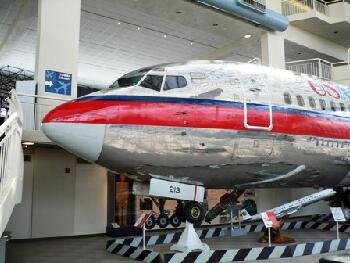 |
|
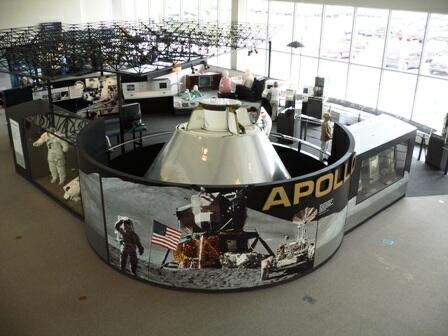
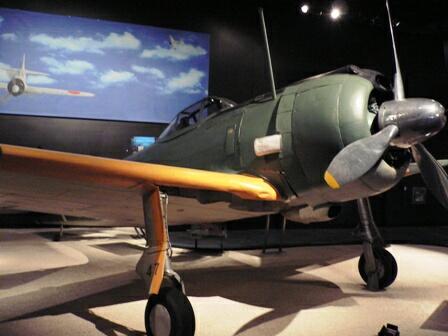
 |
||
| |

Copyright(C) 1998-2006 cerveja<cerveja@or.tv> All rights reserved.
